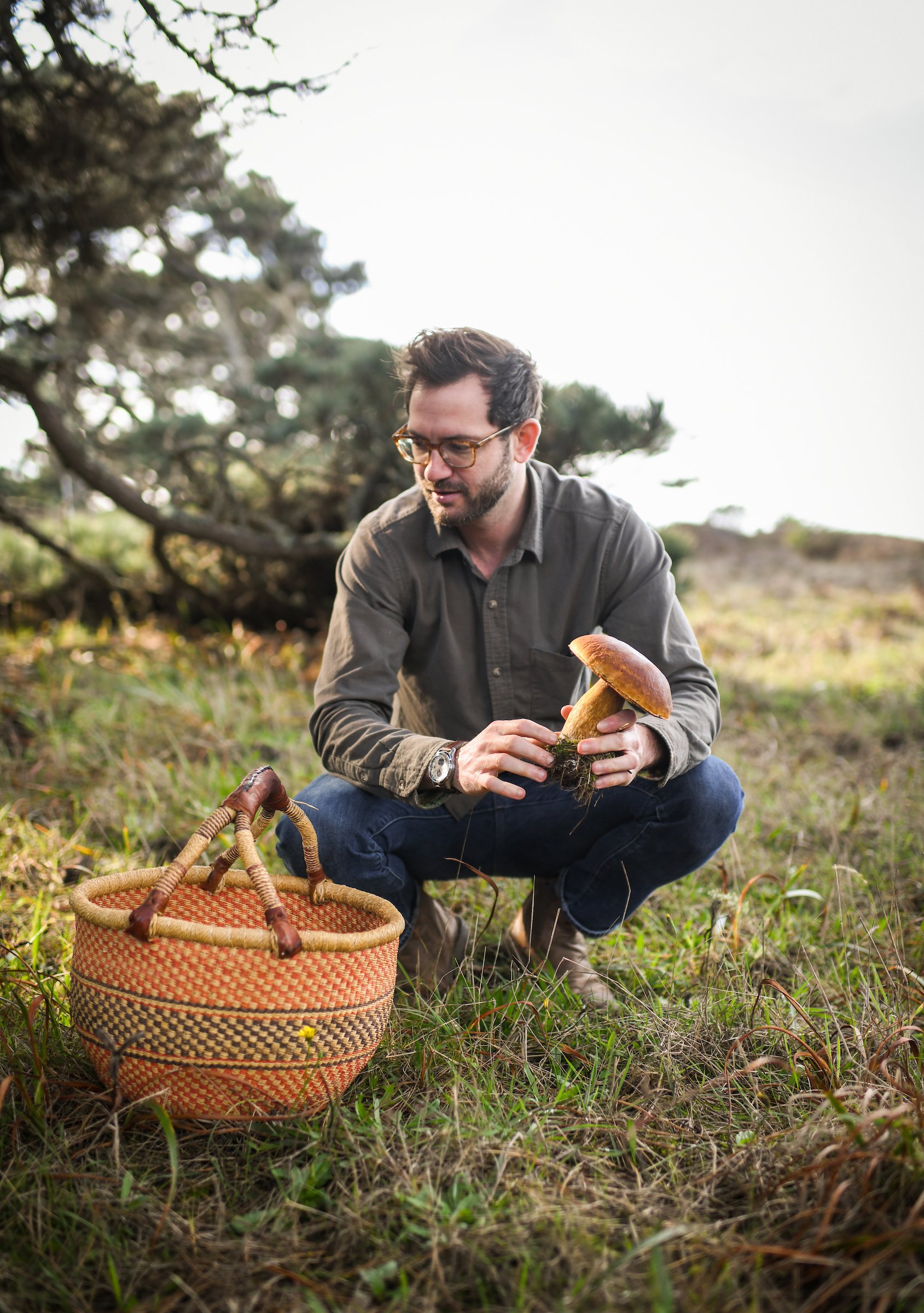Harbor House Inn
“Sustainability is at the core of our decision making. For us, it only makes sense to source from our surroundings with special care to sustainable practices. Being in Elk, you are immersed in one of the most stunning settings, which we would like to preserve for future generations.
All it takes is to ask ourselves “How?” or “Why?” When we begin asking these questions where our food comes from, how it’s raised... we end up with the next question: Why am I serving this?
As chefs, if we show passion and excitement towards local foods and have a more sustainable approach, we will begin to see change. What we do helps educate the public.
It’s been 10 years since I have cooked on the East Coast and being able to come back and cook in a setting like Atomix is an absolute honor. ”
“I have defined my cuisine’s guiding principle as ‘balance’ and ‘harmony’. This extends not just to the palette of texture and flavor, but my approach to sustainability.
Sustainability has been a topic of fervent discussion in our industry. In context of current extreme, man-made situations, how can we regain a balanced, sustainable relationship to nature?
Unsustainable practices such as factory farming, for example, has resulted in the popular opinion that meat consumption, is innately harmful. But rather, it’s harmful in its breaking of the balance of the natural ‘circle of life’. Humans’ relationship with nature is balanced when working at human scale with sustainable practices, which give and take from nature symbiotically.
In cooking, I have found wisdom in ancestral practices that honor cuisine’s pursuit of beauty and pleasure without greed. To keep pace with the seasons and natural cycles; to honor ephemeral flavors and textures through fermentation and preservation methods… is my approach. ”
SMALL BITES
-
Lace lichen
Nori broth
Harbor House Inn Furikake—
Lichens are a simple slow-growing plant that typically forms a low, branching growth on surfaces such as rocks or trees. They are unique in that they are part algae and part fungi. They are important in the environment as early stage succession organisms which provide natural biodegradation which feed back the environment.
As they are highly sensitive to the environment, this delicate organism should only be enjoyed from pristine environments. All lichens and seaweeds are foraged by the Harbor House team near the restaurant.
-
Dureup
Shrimp
Fermented chili—
Dureup, aralia elata shoots, sprouts in the spring. Uniquely, the young sprouts develop directly from its tree branches, and only the young tender green shoots are harvested to eat.
Durep’s mild and fragrant flavors are treasured for not only its deliciousness but its scarcity, only able to be harvested during a small window of time before it matures into a branch. Durep a great expression of Korea’s mountain spring vegetables, its pleasantly bitter flavor known to stimulate a healthy appetite during the transitional seasons.
The plant’s bark and roots are historically used in Korean medicine for its prized healing properties, appreciating the plant in whole.
-
Maitake tempura
Mendocino espelette
Meyer lemon
—Cultivated mushrooms will continue to play a role in our food systems well into the future. As a chef you realize your responsibility to drive food trends for the consumer.
The public change starts with us, and our ability to create delicious foods. A sustainable menu option in New York City was an easy pick for me.
Here we waste nothing of the mushroom, frying and infusing, extracting flavor from even the trims.
-
Almond dubu
Myeongran—
Myeongran is one of the most popular jeotgal, salted preserved dishes made with seafood, in Korean cuisine. Myeongran is made with salted pollack roe, seasoned with gochugaru, red chili powder.
Its popularity is due to the balance of natural savory flavor of the roe, enhanced with the salting method. As a banchan, it’s often joked as a ‘rice thief’, referring to the addictive combination that allows one to easily finish a whole bowl of rice with just this dish. It can also be enjoyed grilled, which enhances its savory notes.
SAVORY
-
Kombujime Scallop
Campfire butter
Douglas fir vinegar
Atomix ferment—
Kombujime is an ancient Japanese method of preserving fish by curing it between layers of konbu, which infuses it with umami.
The kombujime technique developed in Japan before refrigeration to enable the transport of seafood inland from the sea. The konbu not only helps absorb liquid coming off seafood, it also infuses glutamic acids which help to boost the natural umami.
Here, we applied the method to fresh scallops from Massachusetts, pairing with douglas fir vinegar from Harbor House Inn and Atomix ferments.
-
Monkfish liver
Peaky toe
Stonevine—
Dol-namul, known as stonevine or stonecrop, is a leafy succulent that grows well on rocky soil. Abundantly growing in the springtime, to the point where it’s often considered a weed in other parts of the world, the charming vegetable is often enjoyed tossed in many different seasonings or even made into kimchi in Korea.
Its fresh taste, reminiscent of fresh green, cucumber-like minerality, and crisp texture makes it a spring menu favorite, appearing in many forms.
-
Maine sea urchin
Chopped custard
Dulse glaze
Kinome—
Sea urchins, have long been highly coveted delicacies in Japan. In the 1980s, this market was exploited by Maine fishermen, triggering a “gold rush” of urchins.
Because of this intense yet unmanaged harvesting of millions of pounds, Maine now has strict restrictions on fishery, including time limits of harvesting, size limits, and more.
Responsible, respectful harvesting is the only future that ensures ability to continue to enjoy nature’s bounty: a long term vision of the ecosystem.
-
Buckwheat noodle
Ramp
Pine nut—
While we seek to curate world-class ingredients specific to corners of the world to bring to New York City, we also make it a point to work at the local level whenever possible. This includes our ongoing relationships with two foragers, Evan Strusinski and Tama Matsuoka.
Wild foraged ingredients keep us informed of the true pace of nature in our immediate surroundings, which change as quickly as two weeks at a time. When we have the opportunity, Atomix utilizes preservation methods to capture the produce at its peak for us to access throughout the year.
Here, we have prepared our buckwheat noodle with grilled ramp, the marker of spring, and preserved ramp, both from Evan years apart. Accompanied is pine shell oil made from Tama’s precious harvest last year.
-
Abalone in kelp
Wakame
Sea vegetable vinegar
Market vegetables with guts
—When guests ask me if we have a signature dish it's easy to shrug it off. But reflecting back it has become easier to identify the abalone cooked in kelp as a technique driven staple that always has a home on the menu.
Sustainability and this product go hand in hand. Raised in open water underneath Monterey pier, the abalones are fed local kelp, then paired with the sea vegetables from the cove below Harbor House.
The styrofoam they were previously sent in is a packaging of the past as we have worked together to choose more sustainable options which disintegrate when submerged in water. Waste is just as important to reflect on as the product you cook.
-
Red snapper
Razor clam juk
White kimchi—
Kimchi is a representative food of Korea, both a traditional category of food representing the fermentation cuisine of Korea, and a cooking method.
While the most well represented type of kimchi is the spicy red cabbage kimchi which uses gochugaru, there are many different categories of kimchi which utilize a great number of different types of vegetables as well as non-spicy kimchis which do not utilize gochugaru or red peppers at all.
-
Aspragus
Oyster
Fried pork
Market herbs and flowers
—The Union Square Greenmarket began with just a few farmers in 1976. Today, it gathers up to 140 regional farmers, fishers, and bakers at its peak. With rigorous “grow-your-own” standards, the market is a portal to these important growers, allowing us both access to true seasonality, supporting those who grow our food.
Greenmarket's farmers and fishers come from broad a section of the Northeast, including parts of New Jersey, Pennsylvania, New York and New England, providing New Yorkers with a bountiful and astoundingly diverse array of fresh foods.
-
Lamb loin
Dubu muchim
Goat's beard
Wild perilla seed—
In Korea, the springtime is marked by a bounty of herbs and vegetables which provides for Korea’s rich namul culture. Namul refers to both a variety of edible plants, or seasoned herbal dishes made of them. Korean cuisine developed drying methods to elongate enjoyment of select spring vegetables year-round, a category of cuisine dedicated to dehydrated vegetables.Today, we have the beloved goat’s beard from Korea, called ‘sam-namul’, a beloved spring herb that is difficult to source here. The dehydration of goat’s beard accentuates its almost meaty, savory flavor as well as its pleasant chew. The wisdom of extending a season’s unique gifts through these methods allow us to be transported in time.
SWEET
-
Mugwort custard
Key lime
Spruce ice
Pine cone
—Mugwort, which grows well even in harsh environments, has been widely used in Korea for food and medicinal purposes. Young mugworts do not possess as strong of its signature herbaceousness, nor as fibrous of a texture, so they are prized ingredients utilized in many ways: in soup for fragrance, in rice cakes for flavor, enjoyed as an herbal tea, and more. It was also a household staple as a natural incense to drive away bugs, or dried and used for medicinal purposes.
-
Candy cap mushroom
Medocino bee pollen
Grilled honeycomb—
The importance of bees in our ecosystem is well known: bees are a sign of well-functioning ecosystems.
Bees are vital for the preservation of ecological balance and biodiversity in nature, providing one of the most recognizable ecosystem services, pollination, which is what makes food production possible. By doing so, they protect and maintain ecosystems as well as animal and plant species, and contribute to genetic and biotic diversity.
The bee’s hive, home, and food sources are not harmed when honey and honeycomb is harvested responsibly. A beekeeper takes several factors into consideration when harvesting honey such as the time of year, the number of bees in the hive, the amount of honey stored in the hive and the number of flowers available to the bees that season. A healthy beehive will produce more honey than can be eaten by the bees in a season.
〰️
〰️
-
Harbor House Inn Salt
The backbone of our seasoning comes from sea salt that we make in house.
Our salt is collected from the surrounding waters and slowly reduced down with kelp to create a mineral driven umami salt. When tasting next to other sea salts you realize the salt we produce is not ‘salty’, but round and balanced. When combined with other house made seasonings it gives us a singular taste that can not be replicated. It is our single most important ingredient. A process we started on day one, four years ago.
Preserved mango & persimmon
Fermentation, preservation - these are ways to capture the essence of our precious ingredients and to enjoy them year round.
Nature is ever-giving with endless gifts. It is our duty to find ways to appreciate its bounty with honor, without excess or greed. Here, we have prepared two sweet fruits, its flavors captured and fortified through preservation. I hope that these bites can provide you a sweet moment to savor and appreciate the pleasures of nature.

















